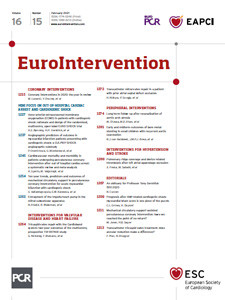
Acute myocardial infarction (AMI) can be complicated by cardiogenic shock (CS) – a state of critical organ hypoperfusion with hypoxia caused by primary cardiac disorders – which occurs in up to 13% of AMI cases1. Left ventricular failure secondary to AMI remains the main cause of CS (approx. 80% of AMI-CS cases). In case of refractory shock, when haemodynamic stabilisation/adequate perfusion cannot be achieved despite implementation of contemporary supportive measures, mechanical circulatory support (MCS) may be initiated to augment cardiac output temporarily. The most frequently used temporary circulatory support devices include the intra-aortic balloon pump (IABP; Getinge Group, Gothenburg, Sweden), percutaneous left ventricular assist devices (pLVAD) such as the Impella® (Abiomed, Danvers, MA, USA), TandemHeart (LivaNova, London, UK), and venoarterial extracorporeal membrane oxygenation (VA-ECMO) systems1,2. The IABP inflates a balloon positioned in the descending aorta during diastole to increase coronary perfusion and deflates the balloon during systole to decrease afterload through a vacuum effect2. However, the IABP failed to reduce mortality in CS patients and is consequently no longer recommended, but should be considered in case MI-related mechanical complications occur3. The Impella is a continuous axial flow pump, which is positioned in the left ventricle to augment flow to the aorta. The Impella can provide blood flow rates up to 5.0 L/min and supports left ventricular unloading2. The TandemHeart consists of an extracorporeal centrifugal continuous flow pump that redirects blood flow from the left atrium to the femoral artery at a flow rate of up to 4.0 L/min and, like the Impella, supports left ventricular unloading2. The VA-ECMO supports circulation and gas exchange with extracorporeal membrane oxygenation. In case of femoro-femoral VA-ECMO, blood is drained from the right atrium, redirected through a membrane oxygenator for oxygenation and decarboxylation, and administered retrogradely into the aorta. Although pLVAD and ECMO are being used increasingly in the management of CS, an evidence base to support their increased application is lacking to date.
In the current issue of EuroIntervention, Vallabhajosyula et al report on national temporal trends, predictors and outcomes of patients admitted with MCS-assisted early percutaneous coronary intervention in the setting of AMI complicated by CS over a period of 10 years4.
The authors utilised the National Inpatient Sample (NIS) database, the largest U.S. all-payer database of hospital inpatient stays, which contains discharge data from a 20% stratified sample of community hospitals in the USA. The authors used International Classification of Disease 9 Clinical Modification (ICD-9CM) codes to identify patients admitted with AMI-CS. Demographic and hospital characteristics, acute organ failure and comorbidities were abstracted from ICD-9CM codes. The primary outcome was the frequency, utilisation trends, and predictors for MCS use during early PCI in AMI-CS. From an estimated 6,111,445 admissions for AMI between January 2005 and December 2014, early PCI for AMI-CS was performed in 110,452 patients. Percutaneous MCS devices were used in 54.8% of admissions with AMI-CS undergoing early PCI. IABP was the predominant MCS applied in 94.8% of admissions, followed by pLVAD in 4.2% and ECMO in 1%. In terms of temporal trends in MCS use, IABP declined continuously while pLVAD and ECMO increased. With regard to multivariable assessment of independent predictors of MCS use, two seemingly opposing trends were observed: on the one hand, younger age, male sex and non-white race with lower comorbidity were associated with MCS use; on the other hand, concomitant cardiac arrest and endotracheal intubation were also found to be predictive of MCS use. Unadjusted mortality was significantly higher in patients undergoing MCS-assisted PCI, while use of MCS was also found to be independently predictive of increased mortality (OR 1.23 [95% CI: 1.19-1.27]; p<0.001) following multivariable adjustment. Within the MCS-assisted PCI cohort, pLVAD and ECMO use were more common in patients with concomitant cardiac arrest and respiratory failure requiring endotracheal intubation compared to IABP use. Consequently, in-hospital mortality was higher in the former groups compared with IABP.
The current findings are enlightening with regard to understanding temporal trends, prediction and mortality of patients undergoing MCS-assisted PCI in the setting of AMI complicated by CS, for which the authors are to be congratulated. The true value of such long-term investigation utilising administrative large-scale databases is indeed in recognising temporal trends of disease prevalence and changes in mortality in a nationwide perspective. However, there remain important peculiarities in data interpretation, which need to be emphasised to ascertain unbiased interpretation of findings for the reader. The main concern about the entire analysis lies in the use of administrative codes to identify disease conditions undergoing further statistical evaluation. In contrast to conventional registries, where patient data are directly reported into individual case report forms, the current study relied on administrative codes from ICD-9CM to classify patients with AMI-CS into those who received MCS and those who did not. Most importantly for this particular study, information on laboratory, imaging and physiological variables with a known impact on mortality during AMI-CS was unavailable. Consequently, it remains speculative whether statistically inferred associations of MCS use and mortality are robust or whether unknown confounders contributed to the current findings. Finally, outcome assessment is limited to the in-hospital setting, while any type of post-discharge outcome or follow-up remains speculative in such an analysis. Given these limitations, the authors conclude that application of MCS identified a sicker cohort of AMI-CS patients. Considering the above-mentioned limitations, the question arises whether the cause and effect relationship may be reversed, where sicker patients are more likely to receive MCS and remain at increased odds for fatal outcome. On the other hand, younger patients with fewer comorbidities were also identified as having received MCS-assisted PCI preferentially during AMI-CS in the current study. One may argue that the inhibition threshold to apply MCS in the setting of AMI-CS may be lower in younger patients with greater life expectancy. Against this notion, this particular group of patients may be least likely to benefit from uniform MCS use and rather be in need of individual Heart Team decision making in order to triage patients more or less likely to benefit from MCS.
What remains significant after all is the fact that mortality remains unacceptably high in this vulnerable patient cohort, irrespective of subgroups, age and confounding factors. In a previous publication reporting on outcome of patients subjected to short-term MCS use and derived from the NIS database, Stretch et al showed an overall decreased mortality from approximately 50% in 2004 to approximately 35% in 20115. Although patient factors may have been different between the populations reported by Stretch and colleagues and the current data set, it is fair to stress that mortality remained high in the years between 2011 and 2014 (30.8% in 2011 and 33.8% in 2014), without obvious trends for improvement in patient outcome, probably not even to the present day.
Consequently, future efforts should re-focus on well-established rapid revascularisation sequences in the setting of STEMI rather than complicating procedural flow and post-procedural patient care.
Conflict of interest statement
H.B. Sager has received funding from the European Research Council under the European Union’s Horizon 2020 Research and Innovation Programme (STRATO, grant agreement No. 759272), the “Else-Kröner-Fresenius-Stiftung” (2020_EKSE.07), and the “Deutsche Forschungsgemeinschaft (DFG)” [SA 1668/5-1]). M. Joner reports personal fees from OrbusNeich, AstraZeneca, and Recor, grants and personal fees from Biotronik, Boston Scientific, and Edwards Lifesciences, and grant support from Amgen outside the submitted work. M. Joner has received funding from the German Center for Cardiovascular Research: DZHK (FKZ 81Z0600502; FKZ 81X2600526) and from the Leducq Foundation (grant agreement number 18CVD02).
Supplementary data
To read the full content of this article, please download the PDF.

